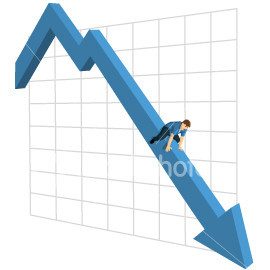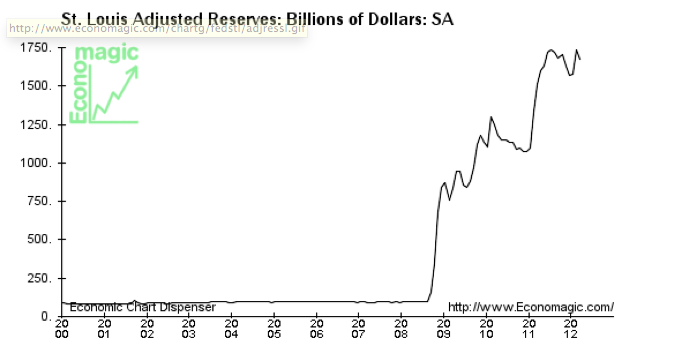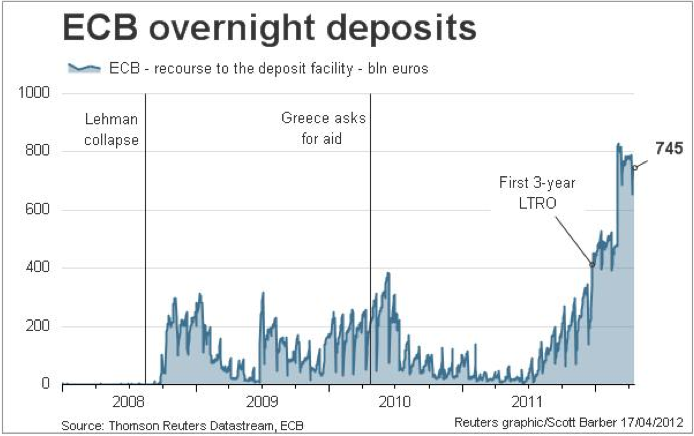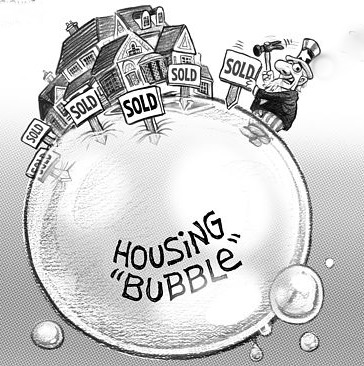Stocks & Equities
Perspective
The stock market is included in the orthodox calculation of Leading Indicators. Problem is that at the end of a great financial bubble, such as in 1929 and 1873, the recession started virtually with the collapse of speculation, which was also the case in 2007. This is one of the features of a bubble and its collapse. Stocks peaked in October 2007 and the recession started in that fateful December.
Essentially, both the stock market and the economy recovered when the panic ended in March 2009. We have thought that the relation would continue such that the first business expansion out of the crash would end with the end of the first bull market. It should be admitted that we had thought that the US expansion would end with the commodity-high of last April. Usually we leave the discussion about recoveries and recessions to the cult of economics, but sometimes it’s worth a try. After all, the NBER typically determines the start of the recession – one year after the actual start.
Naturally, we can’t help but wonder if the life that recently came into the economic numbers will turn down with the stock market – with little delay. Taking out 1340 on the S&P would set the downtrend. What would set the downtrend in GDP?
A couple of weeks ago central bankers were comfortable that stimulus and fixes had – well – fixed things. No more easing was required. Then, this week’s hit to the markets seems to have dislocated policymaker confidence such that Bernanke had to state that he would not raise administered rates. Our view has been that it has been market forces that have lowered such rates. In troubled times conservative funds go to the most liquid items and they are short-dated instruments in the senior currency and gold. This drives the former down in yield and the latter up in price.
The swing in Fed opinion reminds of Tokyo at its extraordinary peak at the end of 1989. Speculation was radical and policymakers were trying to talk the action down – which is always impossible because such speculation will run to collapse. With the initial break in the Nikkei, policymakers became nervous and talked about lowering margin requirements. Shortly after the top of a bubble??? Japan’s subsequent contraction has been one for the history books.
Our “new financial era” recorded a number of cyclical speculative thrusts and cyclical bear markets until a classical bubble was accomplished in 2007. Despite easing that exceeds the determined efforts by the Fed at the start of the post-1929 contraction,
financial history remains on the typical post-bubble path. One could even say that central bankers have been extremely belligerent in attacking the normal forces of contraction.
However, sovereign debt markets are saying that it is not working well. An updated chart on the “Spanish Fandango” follows.
CREDIT MARKETS
With the break in overall confidence, the long bond jumped almost 5 points in three trading days. Junk, high-yield bonds, and sovereign debt sold off. The sub-prime which had rallied from 38 in October to 52.5 in February has slumped to 47.4. The chart has broken down and the target is the 38 of last October. Municipals are close to ending their test of the highs in February.
This year’s seasonal reversal to widening in May could lead to very unsettled credit markets later in the year.
The long bond was oversold and the bounce has corrected this condition and the price is likely to drift down to test the low.
Action in lower-grade stuff has not been healthy, and an economist at an orthodox place (IMF) has discovered that there is not enough collateral behind all of the debt. In Victorian times this was called “over trading” and today its “leveraging”. No matter what the term, it is always followed by liquidation or in today’s terms “de-leveraging”. The next stage could inspire articles that it is impossible for the world’s economy to generate enough income to service the debt burden.
There will be plenty of opportunity for a “new” wave of young economists to point out the glaring blunders of the ancient and “barbarous relic” of interventionist economics.
Commodities
Base metals and crude oil declined enough to prompt a rebound with the Fed turning on the speculation switch again. Neither were oversold enough to set an intermediate bottom. Natural gas got headlines in declining below $2.00, but it is not as oversold as at the 2.23 low in January. Also, late April often sets a seasonal high.
Agricultural prices suffered a hit last week, but not enough to break the chart out of the narrow trading range. Coffee clearly needs a jolt as it has given up most of the huge gain to April last year. It seems that the sector is being keep together by strong action in soybeans and soybean meal. These are becoming rather overbought at close to last year’s highs.
After mid-year, adverse credit spreads, a slowing global economy and a firming dollar could trash most commodities – again. The chart shows three “over-boughts” – at 474 in 2008, 370 last April and at 326 in February.
Currencies
Bernanke renewed his vows to depreciate the dollar, which brought the DX back into its trading range. However, this is still within the pattern leading to a significant advance.
Getting above overhead resistance at 81 could set the launch button. For day-traders May is a long time away, but for investors it is nearby and could record a reversal in credit spreads and forex markets.
BOOM SAYERS to OOOPS!
Signs of the Times:
We ran “Boom Sayer” exclamations for four weeks and considering the nature of volatility it is reasonable to conclude that current excesses will eventually be followed by “Doom Sayers”.
But, let’s not be hasty – usually the next step from complacency is “Ooops!”.
And that might have begun with this week’s discovery that the “fix” on Euroland debt won’t last as long as even the shorter maturities become due.
Pity.
This Year
“The biggest wave of state-and-local government debt refinancing in two decades is helping fuel the longest winning streak for municipal bonds since 2007.”
– Bloomberg, April 2
“Taxable municipal bonds are poised to extend their best rally in 18 years.”
– Bloomberg, April 4
“Across the Eurozone, and beyond, hedge fund managers are now pointing to ‘significant’ pricing anomalies not seen since 2008.”
– Bloomberg, April 6
“JP Morgan trader of credit-derivative indexes [linked to the health of corporations] has amassed positions so large that he is driving price moves in the $10 trillion market.”
– Bloomberg, April 6
Of course, these preceded Tuesday’s setback, but their significance is that there is considerable speculation in credit markets. As we have been noting, favourable trends in corporate spreads ended in February. This could reverse to widening over the next four to six weeks.
As we have been noting, “Boom Sayer” exclamations from March and April last year were remarkably similar to this year’s list. The best of last year’s have been published and, essentially, they ended in April, which suggests a pattern.
Stock market action in both years set a momentum high in February with positive sentiment recorded in March and April – accompanied by bullish raves.
This week saw some “sudden” exclamations of dismay. Does it indicate a new trend?
Link to April 13 ‘Bob and Phil Show’ on TalkDigitalNetwork.com:
http://talkdigitalnetwork.com/2012/04/gold-gloom/


“The question is not whether this is a correction, the correction has got underway. We may easily have a correction of 10% to 20% here.”
also:
Marc Faber : There is no Deflation in the system today except in the housing market


Quotable – “The darkest places in hell are reserved for those who maintain their neutrality in times of moral crisis.” – Dante Alighieri
Commentary & Analysis
[Warning: I am feeling a bit dark this week. So if you want to join me in depression, feel free to read. Otherwise, skip this one. Thanks. Jack]
I finally figured it all out. Our global policymakers are nothing more than Wizard of Oz aficionados (the movie as the book is way over their collective heads). They just love happy endings. Let’s just get all the little people to follow down the yellow brick road and it will all turn out just fine, our pols want to believe.
Of course our politicos’ fairy tale is validated each day by those they love the most–the big people leading us down this path–financial types (defined as anyone who benefits from the financial world, not the real world). It is what it is. Big people are big for a reason. And the big people want that path paved with yet another layer of green paper. Simple!
What is this talk of recession, say the big people? And they say it with their Super Pacs and $40,000 –$50,000 a plate dinners to help elect the top Republicans and Democrats (read totally vetted shills who pledge behind closed doors to keep the status quo the status quo; nothing more than different colored horses from the same stable it seems to me). After all, the financial economy is doing just fine; great in fact, is the refrain from Mr. Financial Big Whig.
But even Mr. Financial Big Whig has a few laments: 1) The price of houses in Greenwich or London; 2) His driver’s parking problems in Davos last year; and 3) The damn 5-minute wait in line at the lift in St. Maritz. What is this recession crap?
I asked JR yesterday (as we watched the local news of Mitt Romney in Palm Beach for a reported $50k a plate stop-over); who is more sickening, the shills panhandling for $40-50k a pop or the crony-istic dregs who actually pony up that much? Decisions, decisions….
To say it is a bifurcated world culturally and materially is to understate the obvious. It is bifurcating down the path of the financial economy versus the real economy, to a large degree. [And if you read Charles Murray’s new book, you get a very bad feeling in the pit of your stomach as to where this is leading.]I realize it is what it is and always has been. But watching it all play out so transparently with such hubris flowing from the top makes it that much more revolting. For example, a bit off point, but if are disgusted with US politics, you have to be stunned to watch the US State Department chastise other countries about the need to “improve their election system”? What a farce! Sorry. These dark thoughts creep in whenever I consider hedge fund managers and pols in the same sentence.]
Back to point, assuming I have one here. Joseph Goebbles would be proud of our central banking wizards. Goebbles, the Nazi propaganda chief, understood the big lie told again and again will sooner or later be believed as truth. All Pols follow this theory. But even Goebbles would be stunned to see how often the Big Lie is used by central banks as the truth stares everyone in the face; the face of those who know how to find US Banking Reserves as listed by the St. Louis Feds research department:
1. If Fed liquidity worked the US would be in the midst of the biggest post-recession boom in history. Instead, we are in the slowest post-recession recovery since Stalin-loving Roosevelt stacked the Supreme Court. Let’s let the reserves speak once again for themselves:

If real growth is taking hold, we should have seen a fall in all these reserves sitting on bank balance sheets.
2. Déjà vu all over again from the ECB. Gee, it did nothing for the US real economy, so why don’t we try it here in Europe, say the Wizards running the European Central Bank (ECB).

The argument to my rant is obvious: So what would you do Jack, let the banking system go bankrupt? Well, yes I would, thank you for asking. One by one and every stinking banker who led his firm down the prim-rose path of derivatives would be history. Super-regional managers would step up to the plate and take their turn. After all it is the regionals and local banks that really know what banking should be anyway…credit and relationships. It isn’t rocket science. [Just look at how massively the powers-that-be, pols and their handlers in the banking system, have attacked Paul Volcker’s very good ideas of what banking should be. Nothing has changed!]
There’s an evenin’ haze settlin’ over town Starlight by the edge of the creek The buyin’ power of the proletariat’s gone down Money’s gettin’ shallow and weak Well, the place I love best is a sweet memory It’s a new path that we trod They say low wages are a reality If we want to compete abroad
My cruel weapons have been put on the shelf Come sit down on my knee You are dearer to me than myself As you yourself can see
While I’m listening to the steel rails hum Got both eyes tight shut Just sitting here trying to keep the hunger from Creeping it’s way into my gut
Meet me at the bottom, don’t lag behind Bring me my boots and shoes You can hang back or fight your best on the frontline Sing a little bit of these workingman’s blues
Well, I’m sailin’ on back, ready for the long haul Tossed by the winds and the seas I’ll drag ’em all down to hell and I’ll stand ’em at the wall I’ll sell ’em to their enemies I’m tryin’ to feed my soul with thought Gonna sleep off the rest of the day Sometimes no one wants what we got Sometimes you can’t give it away
Now the place is ringed with countless foes Some of them may be deaf and dumb No man, no woman knows The hour that sorrow will come
In the dark I hear the night birds call I can feel a lover’s breath I sleep in the kitchen with my feet in the hall Sleep is like a temporary death
Bob Dylan, Workingman’s Blues
At some point, this game must end. The financial world CANNOT continue to widen its gap with the real world ad infinitum. Sooner or later, I think we will learn the path to hell, not Oz, is indeed paved with green paper.
Jack Cooks Black Swan www.blackswantrading.com Currency Currents Blog
Black Swan Capital’s Currency Currents is strictly an informational publication and does not provide personalized or individualized investment or trading advice. Commodity futures and forex trading involves substantial risk of loss and may not be suitable for you. The money you allocate to futures or forex trading should be money that you can afford to lose. Please carefully read Black Swan’s full disclaimer, which is available at http://www.blackswantrading.com/disclaimer

By John Rubino on April 17, 2012
The in-laws own a gas station in Miami that they’ve wanted to sell for years. But they dithered when the market was hot and ended up being stuck with it when interest evaporated in 2009.
Lately, though, the phone has begun to ring again. It’s not exactly a feeding frenzy but real offers are coming from legitimate buyers for the first time in three years.
That’s actually a pretty good description of real estate in general, where low interest rates have convinced a growing number of people that it’s time to buy. See this upbeat story on the home builders:
Pulte, Lennar jump as survey shows housing rebound
NEW YORK (MarketWatch) — Shares of U.S. homebuilders rallied on Wednesday after a Wells Fargo analyst’s research report said data from 20 select markets nationwide are showing strength across the board.
“For the third consecutive month, our survey points to an improvement in orders suggesting 2012 may be the long-awaited recovery year for housing,” the note said.
PulteGroup PHM -1.39% added more than 8%, Lennar Corp. LEN -1.47% gained 5%, D.R. Horton DHI -2.44% rose 4.2% and Toll Bros. TOL -0.86% gained 3.8%.
The bellwether industry ETF, the iShares Dow Jones U.S. Home Construction Index Fund ITB rose 3.4%.
Wells Fargo’s monthly Neighborhood Watch Survey, which tracks 150 sales managers at housing tracts in 20 markets, showed that March results were strong across all measured metrics. In particular, the survey noted that March’s numbers surpassed poll participants’ expectations by the widest margin since the survey started, in 2001.
Wells said that pricing in the 20 markets also improved, both month-to-month and over year-ago figures. Sales managers’ commentary on market activity indicated that buyer confidence seems to be improving as inventory shrinks.
“Sales managers suggested there is a sense of urgency in the marketplace as buyers anticipate higher home prices and/or mortgage rates,” the report said.
Bidding wars are even returning to some markets:
Market squeezing homebuyers
Home shopper Dian Schneider was four houses in on a whirlwind tour of local homes for sale Friday when her real estate agent issued her a warning.
“Now if you like this one you’ll need to move today because there are already two offers on it, and they’re both above list price,” said Anna Hernandez of McKinzie Nielsen Real Estate. “They’re not crazy high, but you’ll have to go in high, too, if you’re serious about it.”
Schneider nodded knowingly as she peeked inside closets, flushed toilets and opened cabinet doors.
The 50-year-old single mom had already missed out on two homes she’d made offers on. She was outbid on one, and pulled out of a second over concerns about its dated electrical system.
“In hindsight, I probably should have taken that one,” Schneider said.
Almost all the available inventory in her price range is badly in need of repairs, and upgrading the electrical on the home she passed up wouldn’t have cost as much as she’d assumed, she later learned. But back then, she didn’t fully appreciate how lucky she’d been to find something.
The Bakersfield area had only 583 single-family homes for sale in March, about a third fewer than in March of last year.
Bidding war return
The result has been fierce bidding wars and almost immediate turnover for anything of quality that’s priced reasonably, whether it’s a modest starter home or a mansion.
“Everybody’s pretty much in the same boat right now, regardless of price,” said Robert Morris, who sells for Watson Realty ERA. “The supply keeps dropping and dropping and there’s nothing replacing it.”
Broker Nancy Harper of Nancy Harper Realty recalled listing a home the day before Easter. By Easter Sunday, it had six offers on it, and when she called the losing agents to tell them their offers had been rejected, two of them burst into tears.
“They told me they’d written something like 14 offers for clients and just couldn’t get one accepted,” Harper said. “When you have agents bursting into tears, boy, that’s low inventory.”
So is the housing bubble back?
To Read More CLICK HERE















